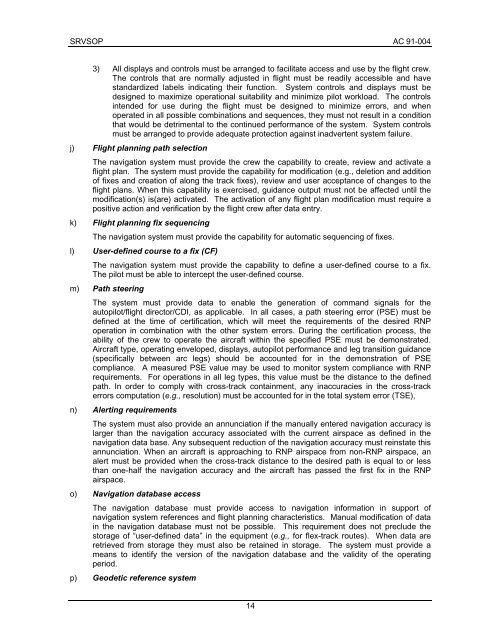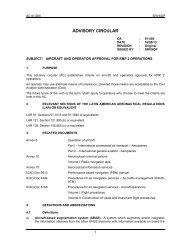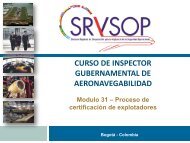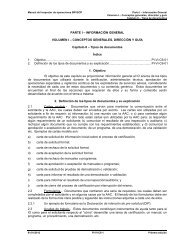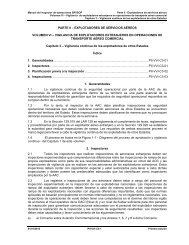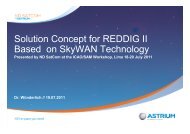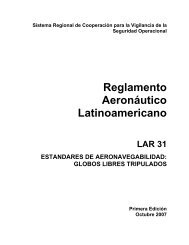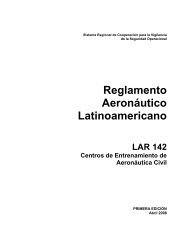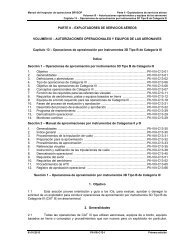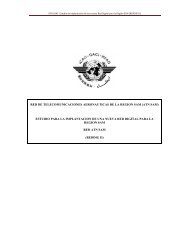ac 91-004 srvsop - ICAO
ac 91-004 srvsop - ICAO
ac 91-004 srvsop - ICAO
Create successful ePaper yourself
Turn your PDF publications into a flip-book with our unique Google optimized e-Paper software.
SRVSOP AC <strong>91</strong>-<strong>004</strong><br />
3) All displays and controls must be arranged to f<strong>ac</strong>ilitate <strong>ac</strong>cess and use by the flight crew.<br />
The controls that are normally adjusted in flight must be readily <strong>ac</strong>cessible and have<br />
standardized labels indicating their function. System controls and displays must be<br />
designed to maximize operational suitability and minimize pilot workload. The controls<br />
intended for use during the flight must be designed to minimize errors, and when<br />
operated in all possible combinations and sequences, they must not result in a condition<br />
that would be detrimental to the continued performance of the system. System controls<br />
must be arranged to provide adequate protection against inadvertent system failure.<br />
j) Flight planning path selection<br />
The navigation system must provide the crew the capability to create, review and <strong>ac</strong>tivate a<br />
flight plan. The system must provide the capability for modification (e.g., deletion and addition<br />
of fixes and creation of along the tr<strong>ac</strong>k fixes), review and user <strong>ac</strong>ceptance of changes to the<br />
flight plans. When this capability is exercised, guidance output must not be affected until the<br />
modification(s) is(are) <strong>ac</strong>tivated. The <strong>ac</strong>tivation of any flight plan modification must require a<br />
positive <strong>ac</strong>tion and verification by the flight crew after data entry.<br />
k) Flight planning fix sequencing<br />
The navigation system must provide the capability for automatic sequencing of fixes.<br />
l) User-defined course to a fix (CF)<br />
The navigation system must provide the capability to define a user-defined course to a fix.<br />
The pilot must be able to intercept the user-defined course.<br />
m) Path steering<br />
The system must provide data to enable the generation of command signals for the<br />
autopilot/flight director/CDI, as applicable. In all cases, a path steering error (PSE) must be<br />
defined at the time of certification, which will meet the requirements of the desired RNP<br />
operation in combination with the other system errors. During the certification process, the<br />
ability of the crew to operate the aircraft within the specified PSE must be demonstrated.<br />
Aircraft type, operating enveloped, displays, autopilot performance and leg transition guidance<br />
(specifically between arc legs) should be <strong>ac</strong>counted for in the demonstration of PSE<br />
compliance. A measured PSE value may be used to monitor system compliance with RNP<br />
requirements. For operations in all leg types, this value must be the distance to the defined<br />
path. In order to comply with cross-tr<strong>ac</strong>k containment, any in<strong>ac</strong>cur<strong>ac</strong>ies in the cross-tr<strong>ac</strong>k<br />
errors computation (e.g., resolution) must be <strong>ac</strong>counted for in the total system error (TSE),<br />
n) Alerting requirements<br />
The system must also provide an annunciation if the manually entered navigation <strong>ac</strong>cur<strong>ac</strong>y is<br />
larger than the navigation <strong>ac</strong>cur<strong>ac</strong>y associated with the current airsp<strong>ac</strong>e as defined in the<br />
navigation data base. Any subsequent reduction of the navigation <strong>ac</strong>cur<strong>ac</strong>y must reinstate this<br />
annunciation. When an aircraft is appro<strong>ac</strong>hing to RNP airsp<strong>ac</strong>e from non-RNP airsp<strong>ac</strong>e, an<br />
alert must be provided when the cross-tr<strong>ac</strong>k distance to the desired path is equal to or less<br />
than one-half the navigation <strong>ac</strong>cur<strong>ac</strong>y and the aircraft has passed the first fix in the RNP<br />
airsp<strong>ac</strong>e.<br />
o) Navigation database <strong>ac</strong>cess<br />
The navigation database must provide <strong>ac</strong>cess to navigation information in support of<br />
navigation system references and flight planning char<strong>ac</strong>teristics. Manual modification of data<br />
in the navigation database must not be possible. This requirement does not preclude the<br />
storage of “user-defined data” in the equipment (e.g., for flex-tr<strong>ac</strong>k routes). When data are<br />
retrieved from storage they must also be retained in storage. The system must provide a<br />
means to identify the version of the navigation database and the validity of the operating<br />
period.<br />
p) Geodetic reference system<br />
14


